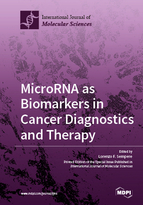MicroRNA as Biomarkers in Cancer Diagnostics and Therapy
A special issue of International Journal of Molecular Sciences (ISSN 1422-0067). This special issue belongs to the section "Molecular Pathology, Diagnostics, and Therapeutics".
Deadline for manuscript submissions: closed (30 November 2018) | Viewed by 50368
Special Issue Editor
2. Precision Health Program, Michigan State University, Interdisciplinary Science and Technology Building, East Lansing, MI 48824, USA
Interests: tissue slide-based microRNA diagnostics; microRNA biology and evolution; cell type-specific activities of microRNAs in oncology with a focus on breast and pancreatic cancer; nanoparticle-based delivery of microRNA activity modulators
Special Issues, Collections and Topics in MDPI journals
Special Issue Information
Dear Colleagues,
MicroRNAs (miRNAs) are small non-coding RNA molecules that function predominantly as post-transcriptional regulators of gene expression. miRNAs play important roles in development, cellular differentiation and homeostasis, and host-virus interactions. miRNA expression and function are dysregulated in cancer. Specific miRNAs have been shown to exert tumor-promoting or tumor-suppressive functions depending of the expressing cell type and cancer site. Within cancer cells, miRNA can modulate growth and chemoresistance, stem cell, epithelial-to-mesenchymal transition and/or metastatic programs. Within other cell types of the tumor microenvironment, miRNAs can promote angiogenic and immune suppressive programs.
Most miRNAs act in a cell-autonomous fashion within the expressing cell, yet miRNAs are an important cargo in extracellular vesicles that can affect specific biological program or pathways in recipient cells. There are several examples of miRNA-mediated cell-to-cell communication that imparts a favorable microenvironment for cancer cell growth and metastasis. Circulating miRNAs either in extracellular vesicles, multi-protein complexes, or in other forms are readily found and often altered in blood and other bio-fluids of cancer patients.
This Special Issue will provide a comprehensive update on the latest findings of cancer-associated miRNAs, with a focus on the clinical application of miRNAs as biomarkers for cancer diagnosis and prognosis, and treatment prediction, as well as miRNA-based therapeutic strategies.
Original papers and review articles that describe advances in detection methodology, bioinformatics approaches, and statistical analysis with an impact on clinical application of miRNAs as cancer biomarkers are welcomed.
Dr. William Chi-shing Cho
Dr. Lorenzo F. Sempere
Guest Editors
Manuscript Submission Information
Manuscripts should be submitted online at www.mdpi.com by registering and logging in to this website. Once you are registered, click here to go to the submission form. Manuscripts can be submitted until the deadline. All submissions that pass pre-check are peer-reviewed. Accepted papers will be published continuously in the journal (as soon as accepted) and will be listed together on the special issue website. Research articles, review articles as well as short communications are invited. For planned papers, a title and short abstract (about 100 words) can be sent to the Editorial Office for announcement on this website.
Submitted manuscripts should not have been published previously, nor be under consideration for publication elsewhere (except conference proceedings papers). All manuscripts are thoroughly refereed through a single-blind peer-review process. A guide for authors and other relevant information for submission of manuscripts is available on the Instructions for Authors page. International Journal of Molecular Sciences is an international peer-reviewed open access semimonthly journal published by MDPI.
Please visit the Instructions for Authors page before submitting a manuscript. There is an Article Processing Charge (APC) for publication in this open access journal. For details about the APC please see here. Submitted papers should be well formatted and use good English. Authors may use MDPI's English editing service prior to publication or during author revisions.
Keywords
- MicroRNA (miRNA, miR)
- Tissue analysis
- Circulating biomarkers (blood, bio-fluids)
- Extracellular vesicle, exosomes
- Cancer diagnosis
- Treatment prediction
- Therapeutics
- Pre-clinical models and clinical trials







